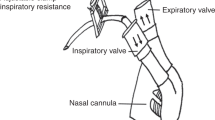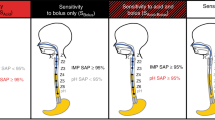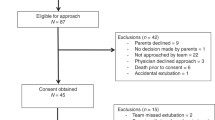Abstract
Objective:
The aim of this study was to characterize cardiorespiratory events in preterm infants after both acid and nonacid gastroesophageal reflux (GER) as detected by pH and multiple intraluminal impedance (MII).
Study Design:
Twelve hour overnight studies were performed in 71 preterm infants (gestational age 29.4±3.0 weeks, birth weight 1319±496 g). Apnea ⩾10 s in duration, bradycardia ⩽80 b.p.m. and oxygen desaturation ⩽85% that occurred within 30 s after the initiation of GER were classified as associated with GER.
Result:
A total of 12 957 cardiorespiratory events and 4164 GER episodes were documented. Less than 3% of all cardiorespiratory events were preceded by GER constituting 3.4% of apnea, 2.8% of oxygen desaturation and 2.9% of bradycardia events. GER did not prolong cardiorespiratory event duration or increase severity. In contrast, GER was associated with a shorter duration of oxygen desaturation events (7.8±4.6 vs 6.3±5.6 s, P<0.05).
Conclusion:
GER is rarely associated with cardiorespiratory events, and has no detrimental effect on cardiorespiratory event duration or severity.
This is a preview of subscription content, access via your institution
Access options
Subscribe to this journal
Receive 12 print issues and online access
$259.00 per year
only $21.58 per issue
Buy this article
- Purchase on Springer Link
- Instant access to full article PDF
Prices may be subject to local taxes which are calculated during checkout



Similar content being viewed by others
References
Malcolm WF, Gantz M, Martin RJ, Goldstein RF, Goldberg RN, Cotten CM et al. Use of medications for gastroesophageal reflux at discharge among extremely low birth weight infants. Pediatrics 2008; 121 (1): 22–27.
Dhillon AS, Ewer AK . Diagnosis and management of gastro-oesophageal reflux in preterm infants in neonatal intensive care units. Acta Paediatr 2004; 93 (1): 88–93.
Tipnis NA, Tipnis SM . Controversies in the treatment of gastroesophageal reflux disease in preterm infants. Clin Perinatol 2009; 36 (1): 153–164.
Hibbs AM, Lorch SA . Metoclopramide for the treatment of gastroesophageal reflux disease in infants: a systematic review. Pediatrics 2006; 118 (2): 746–752.
Bianconi S, Gudavalli M, Sutija VG, Lopez AL, Barillas-Arias L, Ron N . Ranitidine and late-onset sepsis in the neonatal intensive care unit. J Perinatal Med 2007; 35 (2): 147–150.
Pulsifer-Anderson E, Guillet R . National institutes of health recommends the routine use of H2 blockers in preterm infants be carefully evaluated. Neonatal Netw 2006; 25 (3): 223–224.
Guillet R, Stoll BJ, Cotten CM, Gantz M, McDonald S, Poole WK et al. Association of H2-blocker therapy and higher incidence of necrotizing enterocolitis in very low birth weight infants. Pediatrics 2006; 117 (2): e137–e142.
Orenstein SR, Hassall E, Furmaga-Jablonska W, Atkinson S, Raanan M . Multicenter, double-blind, randomized, placebo-controlled trial assessing the efficacy and safety of proton pump inhibitor lansoprazole in infants with symptoms of gastroesophageal reflux disease. J pediatr 2009; 154 (4): 514–520.
Molloy EJ, Di Fiore JM, Martin RJ . Does gastroesophageal reflux cause apnea in preterm infants? Biol Neonate 2005; 87 (4): 254–261.
Di Fiore JM, Arko M, Whitehouse M, Kimball A, Martin RJ . Apnea is not prolonged by acid gastroesophageal reflux in preterm infants. Pediatrics 2005; 116 (5): 1059–1063.
Wenzl TG, Schenke S, Peschgens T, Silny J, Heimann G, Skopnik H . Association of apnea and nonacid gastroesophageal reflux in infants: investigations with the intraluminal impedance technique. Pediatr Pulmonol 2001; 31 (2): 144–149.
Corvaglia L, Zama D, Gualdi S, Ferlini M, Aceti A, Faldella G . Gastro-oesophageal reflux increases the number of apnoeas in very preterm infants. Arch Dis Child Fetal Neonatal Ed 2009; 94 (3): F188–F192.
Mousa H, Woodley FW, Metheney M, Hayes J . Testing the association between gastroesophageal reflux and apnea in infants. J Pediatr Gastroenterol Nutr 2005; 41 (2): 169–177.
Wenzl TG, Moroder C, Trachterna M, Thomson M, Silny J, Heimann G et al. Esophageal pH monitoring and impedance measurement: a comparison of two diagnostic tests for gastroesophageal reflux. J Pediatr Gastroenterol Nutr 2002; 34 (5): 519–523.
Peter CS, Sprodowski N, Bohnhorst B, Silny J, Poets CF . Gastroesophageal reflux and apnea of prematurity: no temporal relationship. Pediatr 2002; 109 (1): 8–11.
Slocum C, Arko M, Di Fiore JM, Martin RJ, Hibbs AM . Apnea, bradycardia and desaturation in preterm infants before and after feeding. J Perinatol 2009; 29 (3): 209–212.
Skopnik H, Silny J, Heiber O, Schulz J, Rau G, Heimann G . Gastroesophageal reflux in infants: evaluation of a new intraluminal impedance technique. J Pediatr Gastroenterol Nutr 1996; 23 (5): 591–598.
Di Fiore JM, Arko M, Churbock K, Hibbs AM, Martin RJ . Technical limitations in detection of gastroesophageal reflux in neonates. J Pediatr Gastroenterol Nutr 2009; 49 (2): 177–182.
Boekema PJ, Samsom M, van Berge Henegouwen GP, Smout AJ . Coffee and gastrointestinal function: facts and fiction. A review. Scand J Gastroenterol Suppl 1999; 230: 35–39.
Jadcherla SR, Duong HQ, Hoffmann RG, Shaker R . Esophageal body and upper esophageal sphincter motor responses to esophageal provocation during maturation in preterm newborns. J Pediatr 2003; 143 (1): 31–38.
Omari TI . Apnea-associated reduction in lower esophageal sphincter tone in premature infants. J Pediatr 2009; 154: 374–378.
Slocum C, Hibbs AM, Martin RJ, Orenstein SR . Infant apnea and gastroesophageal reflux: a critical review and framework for further investigation. Curr Gastroenterol Rep 2007; 9 (3): 219–224.
Arad-Cohen N, Cohen A, Tirosh E . The relationship between gastroesophageal reflux and apnea in infants. J Pediatr 2000; 137: 321–326.
Brooks LJ, Di Fiore JM, Martin RJ . Assessment of tidal volume over time in preterm infants using respiratory inductance plethysmography, the CHIME study group. Collaborative home infant monitoring evaluation. Pediatric Pulmonology 1997; 23 (6): 429–433.
Weese-Mayer DE, Corwin MJ, Peucker MR, Di Fiore JM, Hufford DR, Tinsley LR et al. Comparison of apnea identified by respiratory inductance plethysmography with that detected by end-tidal CO(2) or thermistor. The CHIME study group. Am J Respir Criti Care Med 2000; 162 (2 Part 1): 471–480.
Abu-Shaweesh JM, Dreshaj IA, Haxhiu MA, Martin RJ . Central GABAergic mechanisms are involved in apnea induced by SLN stimulation in piglets. J Appl Physiol 2001; 90 (4): 1570–1576.
Acknowledgements
This work was supported by National Institute of Health Grant K23-HD056299.
Author information
Authors and Affiliations
Corresponding author
Ethics declarations
Competing interests
The authors declare no conflict of interest.
Rights and permissions
About this article
Cite this article
Di Fiore, J., Arko, M., Herynk, B. et al. Characterization of cardiorespiratory events following gastroesophageal reflux in preterm infants. J Perinatol 30, 683–687 (2010). https://doi.org/10.1038/jp.2010.27
Received:
Revised:
Accepted:
Published:
Issue Date:
DOI: https://doi.org/10.1038/jp.2010.27



